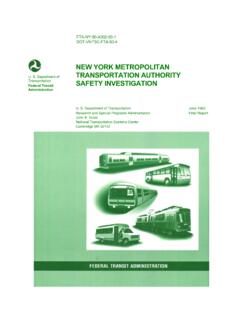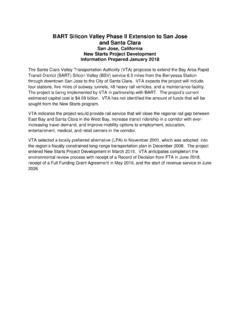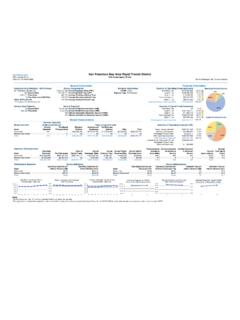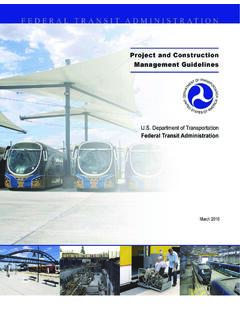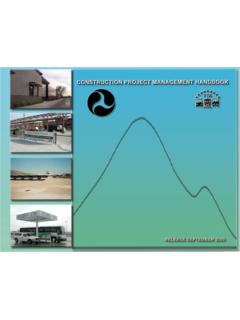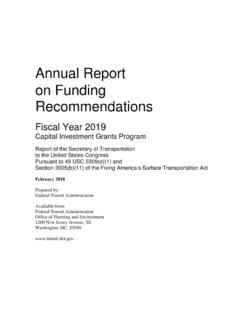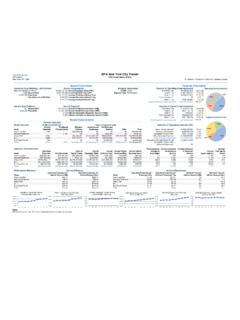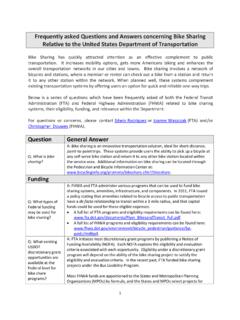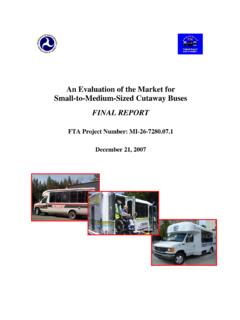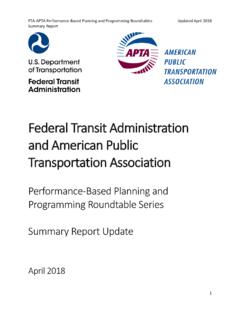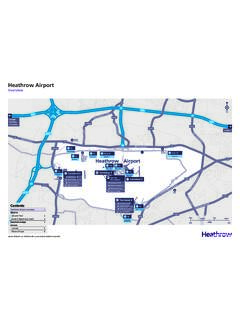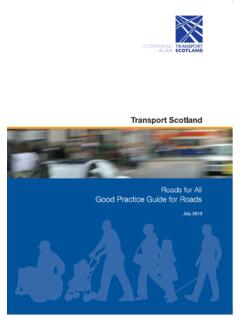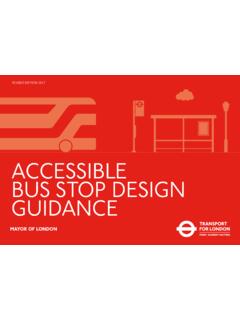Transcription of FTA C 4710.1 Federal Transit Administration November 4, …
1 CIRCULAR. Department of Transportation FTA C Federal Transit Administration November 4, 2015. Subject: AMERICANS WITH DISABILITIES ACT (ADA): GUIDANCE. 1. PURPOSE. This circular provides guidance to recipients and subrecipients of Federal Transit Administration (FTA) financial assistance necessary to carry out provisions of the Americans with Disabilities Act (ADA) of 1990, Section 504 of the Rehabilitation Act of 1973, as amended, and the Department of Transportation's implementing regulations at 49 CFR Parts 27, 37, 38, and 39. 2. CANCELLATION. This is a new circular. It does not cancel any existing directive. 3. SCOPE. This circular applies to all assistance authorized by the Federal Transit Laws (49 Chapter 53) and all programs administered by FTA. 4. AUTHORITIES. a. Americans with Disabilities Act of 1990.
2 B. Section 504 of the Rehabilitation Act of 1973, as amended c. 49 CFR Parts 27, 37, 38, and 39. d. Federal Transit Laws, 49 5301 et seq. 5. WAIVER. FTA reserves the right to waive any requirements of this circular to the extent permitted by law. 6. Federal REGISTER NOTICE. In conjunction with publication of this circular, FTA published a notice in the Federal Register on October 5, 2015, addressing comments received during development of the circular. 7. AMENDMENTS TO THE CIRCULAR. FTA reserves the right to update this circular to reflect changes in other revised or new guidance and regulations that undergo notice and comment, without further notice and comment on this circular. FTA will post updates on our website at The website allows the public to register for notification when FTA issues Federal Register notices or new guidance.
3 Please visit the website and click on sign up for e-mail updates . for more information. 8. 49 CFR REVIEW. The General Counsel of the Department of Transportation has reviewed this document and approved it as consistent with the language and intent of 49 CFR Parts 27, 37, 38, and/or 39, as applicable. 9. accessible FORMATS. This document is available in accessible formats upon request. To obtain paper copies of this circular as well as information regarding these accessible formats, call FTA's Administrative Services Help Desk, at 202-366-4865. Individuals with hearing impairments may contact the Federal Relay Service at 1-800-877-8339 for assistance with the call. Therese W. McMillan Acting Administrator Intentionally Blank Page FTA C Table of Contents TOC i FTA CIRCULAR AMERICANS WITH DISABILITIES ACT GUIDANCE.
4 TABLE OF CONTENTS. CHAPTER 1 INTRODUCTION AND 1-1. 1-1. Regulations Applicable to Public Transit Providers .. 1-2. DOT ADA Regulations .. 1-2. DOT Section 504 1-2. DOT Regulations In 1-3. DOJ ADA 1-3. Applicability of the DOT Regulations .. 1-4. Applicability in 1-4. Services Under Contract or Other Arrangement .. 1-5. When the Stand-in-the-Shoes Requirements Do Not 1-6. Private Entities Receiving 5311 Funding .. 1-6. Private Entities Receiving 5310 Funding .. 1-7. Transportation Services Not Addressed in this Circular .. 1-7. Organization of the Circular .. 1-8. CHAPTER 2 GENERAL 2-1. 2-1. Nondiscrimination .. 2-1. Prohibition Against Discrimination .. 2-1. Right to Use General Public Transportation Services .. 2-2. Prohibition Against Requiring Use of Priority seating .. 2-2. Prohibition Against Imposition of Special Charges.
5 2-3. Prohibition Against Requiring Use of Attendants .. 2-3. Prohibition Against Refusing Service Due to Insurance 2-4. Service Denial Due to Rider Conduct .. 2-4. Determining Seriously Disruptive 2-5. Determining a Direct Threat .. 2-5. Steps to Take Before Refusing Service .. 2-5. Right of Individuals to Contest Service Denials .. 2-6. Equipment Requirements for accessible Service .. 2-6. Using Accessibility Features .. 2-6. Maintaining Accessibility Features .. 2-6. Accommodating Riders Who Rely on Working Accessibility Features .. 2-7. Ensuring Accessibility Features Are Free from Obstructions .. 2-8. Keeping Lifts/Ramps in Operative Condition .. 2-8. Reporting Lift Failures and Removing Vehicles From Service .. 2-9. Lift/Ramp and Securement 2-10. Accommodating Riders Using 2-10. Wheelchair Definition.
6 2-10. Legitimate Safety Requirements .. 2-11. Using Designated Securement 2-11. Maintaining an Inventory of Lifts/Ramps and Securement Areas .. 2-12. Boarding Separately from a Wheelchair .. 2-12. Boarding and Alighting Direction .. 2-12. Accommodating Riders Using Other Mobility Devices .. 2-13. Use of Securement 2-13. Use of Seat Belts and Shoulder 2-14. Requesting that Riders Transfer to a 2-15. Allowing Standees on Lifts/Ramps .. 2-15. Assistance by Transit Agency Personnel .. 2-15. Lifts/Ramps and Securement .. 2-15. Other General Assistance .. 2-16. Service 2-17. Oxygen Supplies .. 2-18. FTA C Table of Contents TOC ii accessible Information .. 2-18. accessible 2-19. accessible Websites .. 2-19. Alternatives to Audio Communications .. 2-20. Personnel Training .. 2-20. Types of Training.
7 2-21. Other Considerations .. 2-21. Involving Individuals with Disabilities .. 2-21. Refresher Training .. 2-22. Reasonable Modification of Policy .. 2-22. 2-22. Responding to Reasonable Modification Requests .. 2-23. Exceptions to Granting Reasonable Modification 2-24. Written Policies and 2-25. CHAPTER 3 TRANSPORTATION FACILITIES .. 3-1. 3-1. ADAAG and DOT Standards for Facilities .. 3-1. Transit Agency Jurisdiction .. 3-3. Coordination with Other Entities .. 3-3. Shared Intercity (Amtrak) and Commuter Rail 3-3. Bus Stops .. 3-4. BRT 3-4. Common Issues in Applying the DOT Standards .. 3-5. Common Issues with Station Parking .. 3-5. Number of accessible 3-5. Location of accessible 3-5. Common Issues with Passenger Loading 3-6. Common Issues with Curb Ramps .. 3-7. Common Issues with Track Crossings.
8 3-8. Common Issues with Station Platforms .. 3-9. Detectable 3-9. Station Name Signage .. 3-9. Directions to accessible Means of 3-9. New Construction of Transportation Facilities .. 3-10. 3-10. Structural Impracticability .. 3-10. Alteration of Transportation 3-11. Maximum Extent Feasible .. 3-11. General Alterations .. 3-13. When the Altered Area Is the Path of Travel .. 3-13. Areas of Primary Function and Path of Travel .. 3-14. Disproportionate 3-15. Accessibility Improvements When Costs Are 3-16. Platform-Vehicle Coordination .. 3-18. Rapid Rail Platforms .. 3-20. Light Rail 3-20. Intercity, Commuter, and High-Speed Rail 3-22. Level Boarding .. 3-22. Stations Not Shared with Freight Rail 3-22. Stations Shared with Freight Rail Operations .. 3-23. Process for Approval of Methods Other Than Level-Entry Boarding.
9 3-24. Requirements for a Combination of Low and High 3-25. Platform Width of New or Altered Platforms .. 3-26. Key 3-26. Public Transportation Programs and Activities in Existing Facilities .. 3-28. FTA C Table of Contents TOC iii CHAPTER 4 VEHICLE ACQUISITION AND SPECIFICATIONS .. 4-1. 4-1. Standards for accessible Vehicles .. 4-1. Elements of accessible 4-2. Stand-in-the-Shoes Acquisition Requirements .. 4-4. Acquisition Requirements for Public Entities In 4-5. Buses and 4-6. New Fixed Route Bus or Van Acquisition .. 4-6. Used Fixed Route Bus or Van Acquisition .. 4-7. Remanufactured Fixed Route Bus or Van Acquisition .. 4-8. Historic Buses .. 4-9. Demand Responsive Bus or Van Acquisition of Inaccessible Vehicles .. 4-9. Considerations for Acquiring accessible Buses and Vans .. 4-10. Lifts.
10 4-10. Ramps .. 4-13. Securement Systems .. 4-13. Priority seating 4-15. Rapid and Light Rail Vehicles .. 4-15. New Rapid or Light Rail Vehicle Acquisition .. 4-15. Used Rapid or Light Rail Vehicle 4-16. Remanufactured Rapid or Light Rail Vehicle Acquisition .. 4-17. Historic Rapid or Light Rail 4-18. Considerations for Acquiring accessible Rapid Rail Cars .. 4-18. Doorway-Platform Gaps .. 4-18. Priority seating Signs and Interior 4-19. Between-Car 4-19. Considerations for Acquiring accessible Light Rail 4-20. Doorway-Platform Gaps .. 4-20. Boarding 4-20. Priority seating Signs and Interior 4-21. Between-Car 4-21. Commuter Rail 4-23. New Commuter Rail Car Acquisition .. 4-23. Used Commuter Rail Car Acquisition .. 4-23. Remanufactured Commuter Rail Car Acquisition .. 4-25. Historic Commuter Rail Cars.
